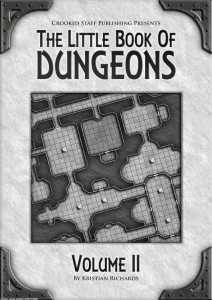The Little Book of Dungeons, Volume II
The Little Book of Dungeons, Volume II is a collection of dungeon maps published by Crooked Staff Publishing and cartography by Kristian Richards.
By Aaron T. Huss

As with the Volume I review, The Little Book of Dungeons is not a collection of printable battlemaps to be placed onto your tabletop and used with miniatures. Rather, it is a collection of maps that can be translated onto an erasable surface, referenced on paper, or simply dictated during game-play. These maps are designed as dungeons for fantasy play, but are drawn generic enough that they can be used outside of fantasy systems and settings. In fact, they can easily be translated into building schematics for sci-fi games or mines or temples for pulp games. Essentially, The Little Book of Dungeons is actually filled with a collection of maps that are drawn simple enough to be translated into multiple genres.
Again, there are nine total maps all drawn as 35 tiles by 50 tiles. Instead of reiterating what was said in the Volume I review (which can be read here), I’m going to speak about how well this second volume advances the series instead of simply repeating the first volume. There are some unique features in this collection compared to the first collection. However, four of the maps are very similar in nature and similar to those found in the first publication. The remaining five maps contain the unique features.
One map has a great looking “bridge” over an underground river before entering the dungeon. A second map uses a river theme with a couple small, sculpted rivers underground which would work great outside of fantasy as well. These five more unique maps utilize a good combination of caves (instead of sculpted dungeon), interesting hallways (not simply straight), and a good use of levels (even those only a few steps apart). These features along with unique room structures make for interesting maps that don’t simply follow those already presented in the first publication.
OVERALL
After a solid set in Volume I, I would expect to see more than just standard maps in Volume II. Over half of the maps contain several unique features, but some seem like more of the same thing. The problem with designing simple maps is that they can easily be replicated with other tile products. To further this series of products, unique features need to be incorporated in all the maps.
RATINGS
Publication Quality: 9 out of 10
The Little Book of Dungeons, Volume II is as clean and effective as Volume I. The details continue to remain crisp and clear and the use of shadows makes the different floor heights very obvious. The effects of the underground river look fantastic along with all other unique features like the bridges and what appears to be a sunken floor. The quality is primarily influenced by this visual appeal.
Visual Appeal: 10 out of 10
As with Volume I, these are excellent looking maps that don’t need color to look great. The use of shadows in the grey-scale makes it easy to understand the pattern of the stairs and steps. The cave system in one of the maps has some wonderful textures creating a 3-D effect, again with the use of well-placed shadows. The simplicity is almost as appealing as the use of shadows creating the proper perspective. Because this is not a 1-to-1 scale battlemap, color would probably ruin the appeal.
Desire to Use: 6 out of 10
Five of the nine maps contain unique features that make them stand out and difficult to replicate otherwise. The other four remind me of standard, old-school dungeon crawl maps that can easily be replicated with the myriad battlemap tiles available. To make a product stand-out that is a map that has to be translated onto another medium really needs to have unique features on every map. Those five maps do carry very unique features that make this volume worth purchasing.
Overall: 8 out of 10
The Little Book of Dungeons is a unique style of product which depicts extensive maps for translation during games. They cannot be simply printed and used as a battlemap and are not designed to be used as tiles. The result is a collection of maps, instead of just one, that are quite large and detailed. The key to pursuing this style of publication is to make them unique and not “like everything else”. You still get multiple maps (nine in this volume) allowing you to mix and match for the ultimate dungeon (or temple, underground city, encampment, mine, etc…). Another positive note is that the maps don’t have to be translated into dungeons but can be used in other genres as well.


